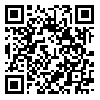Volume 16, Issue 1 (Occupational Medicine Quarterly Journal 2024)
tkj 2024, 16(1): 43-52 |
Back to browse issues page
Research code: 6417
Ethics code: IR.BUMS.REC.1402.325
Download citation:
BibTeX | RIS | EndNote | Medlars | ProCite | Reference Manager | RefWorks
Send citation to:



BibTeX | RIS | EndNote | Medlars | ProCite | Reference Manager | RefWorks
Send citation to:
Hosseini M H. Ergonomic evaluation of working conditions using QEC and ART methods and the prevalence of musculoskeletal disorders in a tile industry. tkj 2024; 16 (1) :43-52
URL: http://tkj.ssu.ac.ir/article-1-1274-en.html
URL: http://tkj.ssu.ac.ir/article-1-1274-en.html
Birjand university of medical sciences , mhhossani@yahoo.com
Full-Text [PDF 898 kb]
(490 Downloads)
| Abstract (HTML) (866 Views)
Ergonomic evaluation of working conditions using QEC and ART methods and the prevalence of musculoskeletal disorders in a tile industry
Hosseini MH 1[†]
1 Department of Occupational Health and Safety Engineering, School of Health, Social Determinants of Health Research Center, Birjand University of Medical Sciences, Birjand, Iran
Abstract
Introduction: The QEC and ART methods are useful tools to identify risk factors that cause work-related musculoskeletal disorders in industries, so the aim of this research is ergonomics evaluation of working conditions using these methods and determining the prevalence of musculoskeletal disorders in the tile industry.
Materials and Methods: In this cross-sectional study, working conditions in a tile industry were evaluated using QEC and ART methods in 2023. Also, the musculoskeletal disorders of 66 workers were recorded using the Nordic questionnaire. The data was analyzed by SPSS software (V.19), and chi-square, independent t-test, Fisher test, and Pearson correlation coefficient were used.
Results: The mean and standard deviation of the age of the studied workers was 30.6±6.11 years, work experience was 5.97±4.95 years, and their body mass index was 23.69±3.42. 68% of workers had at least one musculoskeletal discomfort. The most common discomfort was back pain (50%). There was a significant relationship between shoulder, back, leg, and wrist discomfort with work experience (P<0.05). There was also a significant relationship between discomfort in the shoulders and wrists with age (P<0.05). A positive and significant correlation was obtained between the scores of ART and QEC methods (for QEC with right ART r=0.591 P<0.001 and for QEC with left ART r=0.524 and P<0.001).
Conclusion: Considering the high prevalence of musculoskeletal disorders in this industry, it is necessary to modify workstations according to the results of ART and QEC methods.
Keywords: ART, QEC, tile industry, work related musculoskeletal disorders.
![]()
Full-Text: (776 Views)
Ergonomic evaluation of working conditions using QEC and ART methods and the prevalence of musculoskeletal disorders in a tile industry
Hosseini MH 1[†]
1 Department of Occupational Health and Safety Engineering, School of Health, Social Determinants of Health Research Center, Birjand University of Medical Sciences, Birjand, Iran
Abstract
Introduction: The QEC and ART methods are useful tools to identify risk factors that cause work-related musculoskeletal disorders in industries, so the aim of this research is ergonomics evaluation of working conditions using these methods and determining the prevalence of musculoskeletal disorders in the tile industry.
Materials and Methods: In this cross-sectional study, working conditions in a tile industry were evaluated using QEC and ART methods in 2023. Also, the musculoskeletal disorders of 66 workers were recorded using the Nordic questionnaire. The data was analyzed by SPSS software (V.19), and chi-square, independent t-test, Fisher test, and Pearson correlation coefficient were used.
Results: The mean and standard deviation of the age of the studied workers was 30.6±6.11 years, work experience was 5.97±4.95 years, and their body mass index was 23.69±3.42. 68% of workers had at least one musculoskeletal discomfort. The most common discomfort was back pain (50%). There was a significant relationship between shoulder, back, leg, and wrist discomfort with work experience (P<0.05). There was also a significant relationship between discomfort in the shoulders and wrists with age (P<0.05). A positive and significant correlation was obtained between the scores of ART and QEC methods (for QEC with right ART r=0.591 P<0.001 and for QEC with left ART r=0.524 and P<0.001).
Conclusion: Considering the high prevalence of musculoskeletal disorders in this industry, it is necessary to modify workstations according to the results of ART and QEC methods.
Keywords: ART, QEC, tile industry, work related musculoskeletal disorders.
|
This paper should be cited as:
Hosseini MH. Ergonomic evaluation of working conditions using QEC and ART methods and the prevalence of musculoskeletal disorders in a tile industry. Occupational Medicine Quarterly Journal. 2024; 16(1): 43-52. |
1 گروه مهندسی بهداشت حرفه ای و ایمنی، دانشکده بهداشت، مرکز تحقیقات عوامل اجتماعی موثر بر سلامت، دانشگاه علوم پزشکی بیرجند، بیرجند، ایران
* (نویسنده مسئول)؛ تلفن تماس: 32381684 -056 پست الکترونیک: mhhossani@yahoo.com
تاریخ دریافت: 07/09/1402. تاریخ پذیرش: 18/11/1402
* (نویسنده مسئول)؛ تلفن تماس: 32381684 -056 پست الکترونیک: mhhossani@yahoo.com
تاریخ دریافت: 07/09/1402. تاریخ پذیرش: 18/11/1402
* Corresponding Author
Email: mhhossani@yahoo.com
Tel: +985632381684
Received: 28.11.2023 Accepted: 07.02.2024
Email: mhhossani@yahoo.com
Tel: +985632381684
Received: 28.11.2023 Accepted: 07.02.2024
Type of Study: Research |
Subject:
Ergonomics
Received: 2023/11/28 | Accepted: 2024/02/29 | Published: 2024/03/17
Received: 2023/11/28 | Accepted: 2024/02/29 | Published: 2024/03/17
Send email to the article author
| Rights and permissions | |
 |
This work is licensed under a Creative Commons Attribution-NonCommercial 4.0 International License. |







